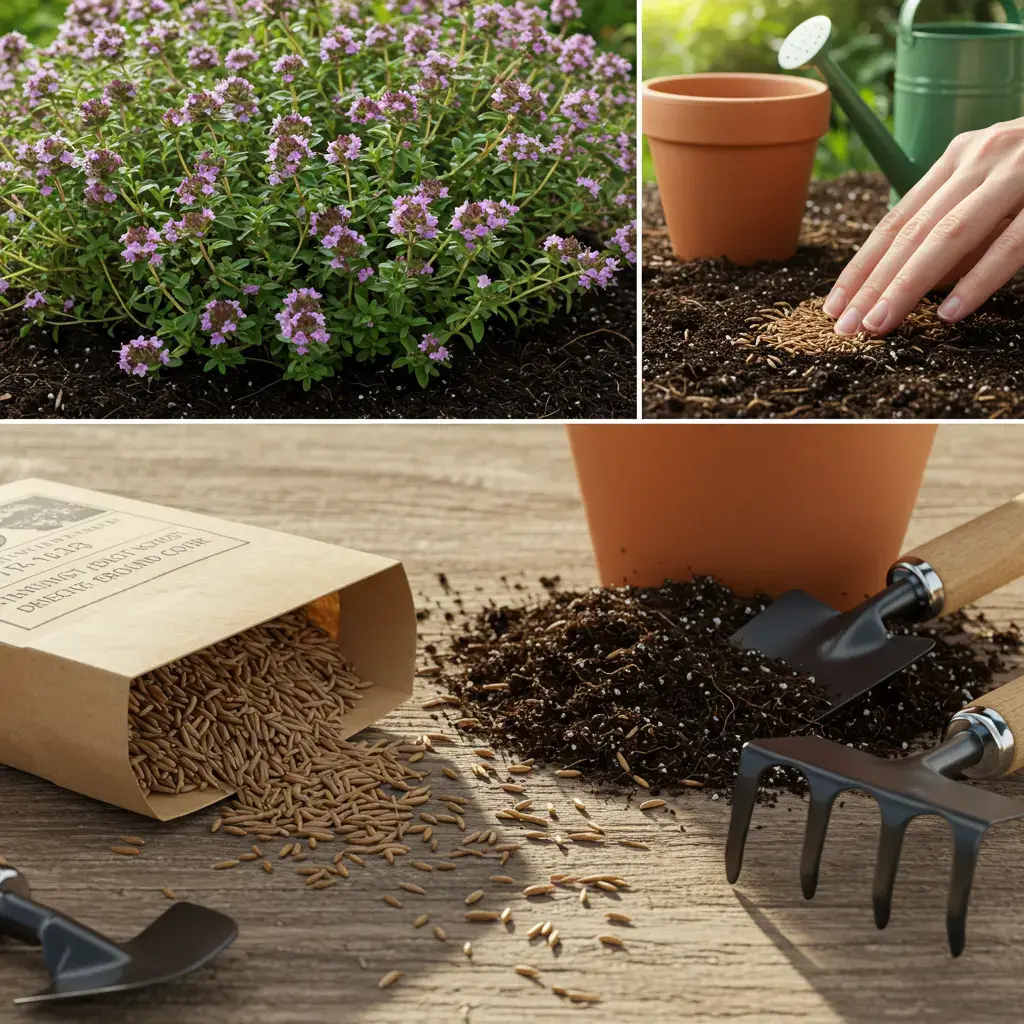Are you looking for a beautiful, eco-friendly lawn alternative? Consider using creeping thyme seeds to create a lush, fragrant, and drought-tolerant outdoor space. This low-maintenance option not only reduces water consumption but also attracts pollinators, enhancing your garden’s biodiversity.
By choosing creeping thyme, you can enjoy a stunning, green lawn that is both beautiful and sustainable. Its aromatic properties fill the air with a pleasant scent, making your outdoor space even more enjoyable. As a hardy, adaptable plant, creeping thyme is perfect for homeowners seeking a low-fuss, environmentally friendly lawn solution.
Key Takeaways
- Creeping thyme is a drought-tolerant, eco-friendly lawn alternative.
- It attracts pollinators, enhancing garden biodiversity.
- Creeping thyme is low-maintenance and reduces water consumption.
- Its aromatic properties create a pleasant outdoor space.
- It’s a hardy, adaptable plant suitable for various climates.
The Magic of Creeping Thyme as a Lawn Alternative
If you’re looking for a lawn alternative that’s both beautiful and sustainable, consider creeping thyme. This versatile ground cover is not only aesthetically pleasing but also offers numerous environmental benefits, making it an attractive option for homeowners.
What Makes Creeping Thyme Special
Creeping thyme is known for its aromatic properties. The fragrance is released when its leaves are bruised or crushed, filling the air with a pleasant, herbal scent.
Aromatic Properties and Benefits
This fragrance is not only pleasing but also contributes to its appeal as a garden feature.
Low-Growing Habit and Coverage Potential
It has a low-growing habit, forming a dense mat that suppresses weeds and prevents soil erosion, making it ideal for areas with poor soil.
Environmental Benefits of Thyme Lawns
Thyme lawns are eco-friendly, offering several environmental advantages.
Water Conservation Advantages
Creeping thyme is drought-tolerant, requiring less water than traditional lawns, making it perfect for water-conscious homeowners.
Pollinator-Friendly Characteristics
It’s also pollinator-friendly, attracting bees and butterflies, thus supporting local biodiversity.
By choosing creeping thyme, you’re not only enhancing your outdoor space but also contributing to a more sustainable environment.
Popular Variities of Creeping Thyme
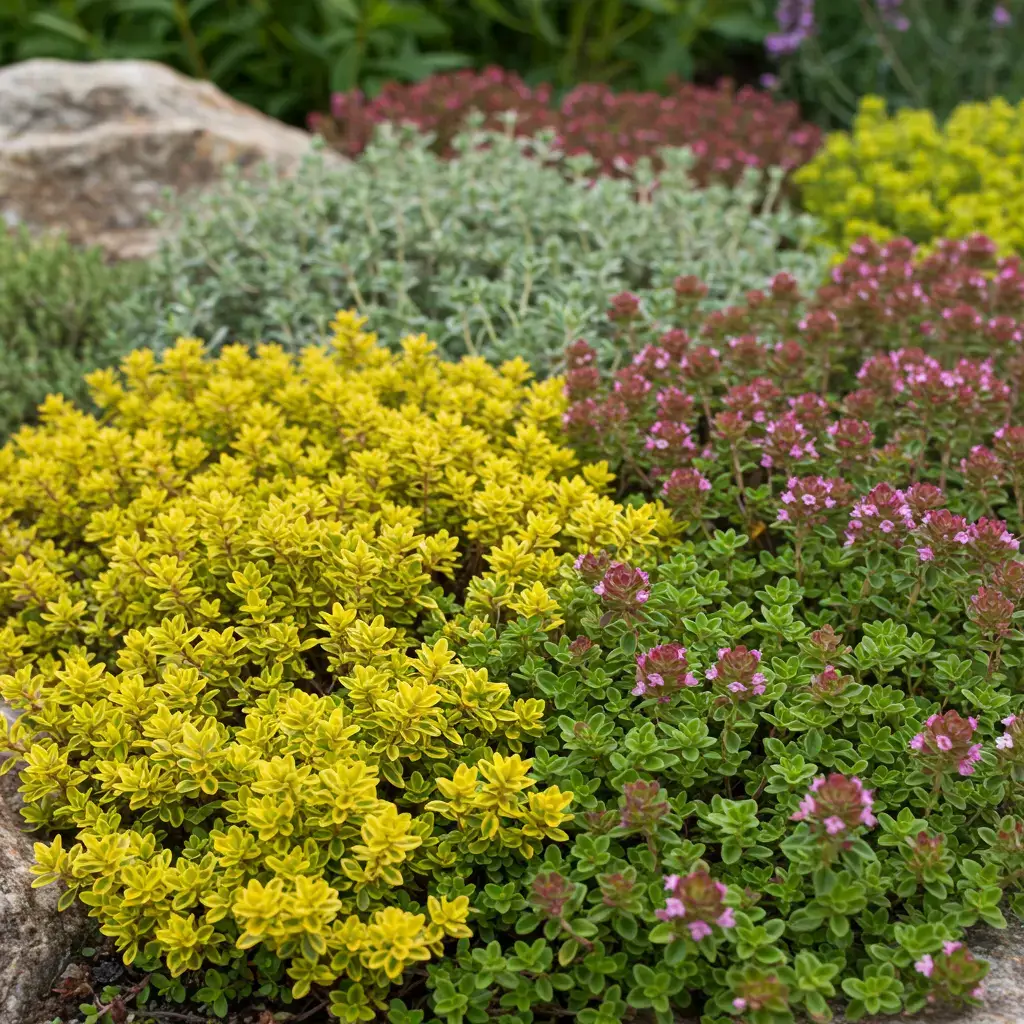
For those looking to cultivate a fragrant and drought-tolerant lawn, exploring the different varieties of creeping thyme is essential. Creeping thyme comes in several types, each with its unique characteristics, growth habits, and uses in landscaping.
Red Creeping Thyme (Thymus serpyllum ‘Coccineus’)
Red Creeping Thyme is a popular variety known for its vibrant red flowers and dense mat-forming habit. It is an excellent choice for areas where a hardy, weed-suppressing ground cover is needed.
Appearance and Growth Habits
This variety grows to form a dense, weed-suppressing mat. It is characterized by its bright red flowers that bloom in early summer, creating a vibrant display.
Best Uses in Landscaping
Red creeping Thyme is ideal for rock gardens, walkways, and between stepping stones, where its fragrance can be appreciated and its beauty can be showcased.
Creeping Red Thyme (Thymus praecox)
Creeping Red Thyme is another widely cultivated variety, admired for its rapid spread and deep red flowers. It thrives in poor soils and can tolerate foot traffic, making it suitable for a variety of landscaping needs.
Distinctive Features
It has a prostrate growth habit, spreading quickly to form a dense carpet. The dark green foliage is aromatic and remains attractive throughout the growing season.
Ideal Growing Conditions
This variety prefers well-drained soil and full sun. It is drought-tolerant once established, making it an excellent choice for water-conscious landscaping.
Other Notable Varieties
Beyond Red Creeping Thyme and Creeping Red Thyme, other varieties like Woolly Thyme and Elfin Thyme offer unique qualities for different landscaping applications.
Woolly Thyme
Woolly Thyme is known for its soft, fuzzy foliage and is often used in areas where a soft texture is desired.
Elfin Thyme
Elfin Thyme is a compact variety that forms a tight, dense mat. It is ideal for small spaces and containers, offering a fragrant and attractive display.
Choosing and Purchasing Creeping Thyme Seeds
When it comes to cultivating a fragrant and drought-tolerant lawn, selecting the right creeping thyme seeds is crucial. The quality of the seeds you choose will directly impact the success of your thyme lawn.
What to Look for in Quality Seeds
To ensure you’re getting the best seeds, there are several factors to consider. Germination rates and freshness indicators are key to determining seed viability.
Germination Rates and Freshness Indicators
Look for seeds with high germination rates, typically above 80%. Freshness indicators, such as packaging dates or testing reports, can also provide assurance of seed quality. As noted by a leading supplier, “Freshness is paramount; old seeds may not germinate as well as fresh ones.”
Organic vs. Conventional Options
You also need to decide between organic and conventional seeds. Organic seeds are grown without synthetic pesticides or fertilizers, appealing to those who prefer sustainable practices. Conventional seeds, on the other hand, may offer a wider variety and are often more affordable.
Where to Buy Creeping Thyme Seeds Bulk
Once you’ve decided on the type of seeds you want, it’s time to find a reliable supplier. You can buy creeping thyme seeds bulk from reputable online suppliers or local nurseries.
Reputable Online Suppliers
Online suppliers like Seed Savers Exchange or High Mowing Seeds offer a wide range of thyme varieties and often provide detailed product information, including germination rates and packaging dates.
Local Nursery Options
Local nurseries can also be a great resource, offering the advantage of seeing the seeds or plants before purchasing. They may also provide valuable advice on growing conditions and care.
Planting Creeping Thyme Seeds: Step-by-Step Guide
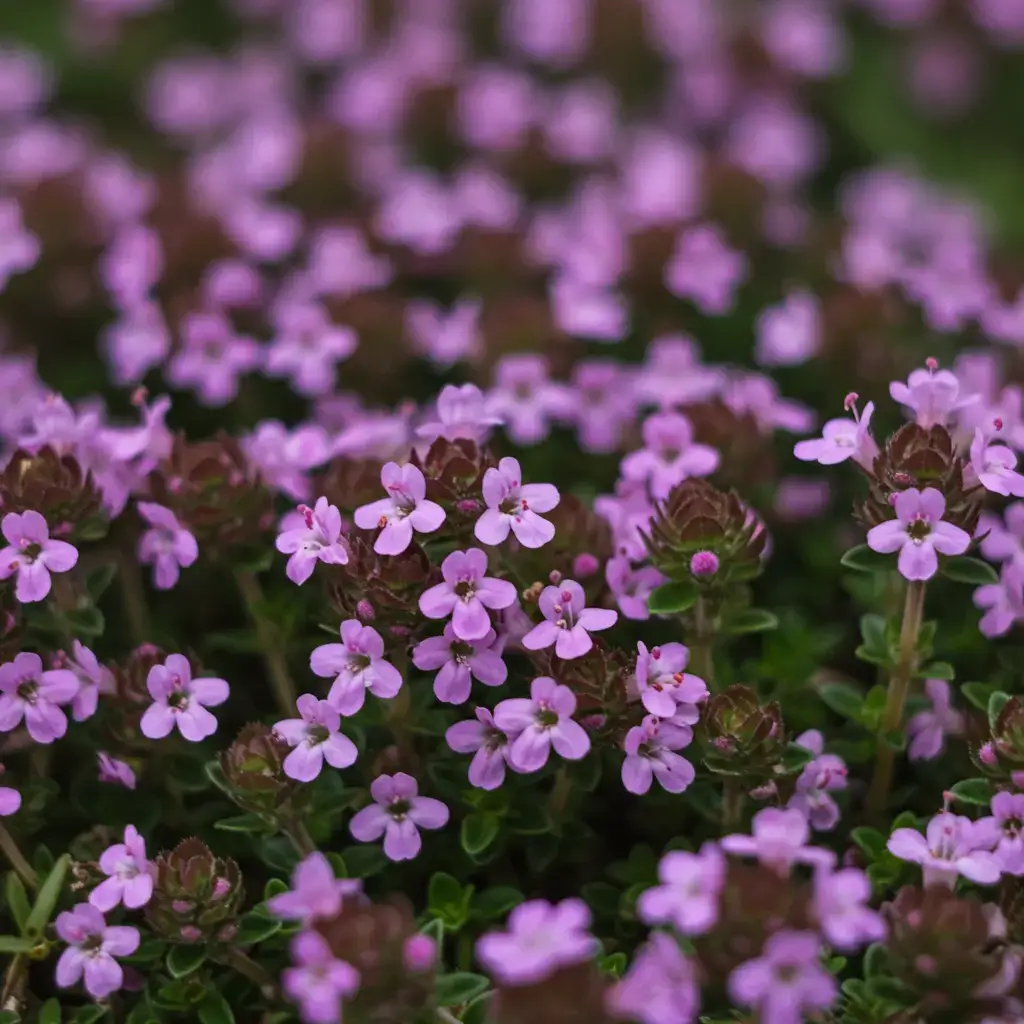
To establish a thriving creeping thyme lawn, it’s essential to follow a step-by-step planting guide. This ensures that your bulk creeping thyme seeds are given the best chance to germinate and grow into a beautiful, fragrant carpet.
Best Time to Plant in Different Climates
The ideal time to plant creeping thyme seeds varies depending on your climate. Generally, spring and fall are considered the best seasons.
Spring Planting Guidelines
In temperate climates, spring is an excellent time to plant creeping thyme. The soil has cooled from the winter, and the air temperature is mild, promoting healthy germination.
Fall Planting Considerations
For regions with hot summers, fall planting is recommended. This allows the seeds to establish themselves before the heat sets in.
Site Selection and Soil Preparation
Choosing the right location and preparing the soil are crucial for the success of your creeping thyme lawn.
Ideal Soil Composition
Creeping thyme prefers well-draining soil with a slightly acidic to neutral pH (6.0-7.0). Amending the soil with organic matter can improve its structure and fertility.
Drainage Requirements
Ensure the planting area drains well to prevent waterlogged soil, which can be detrimental to creeping thyme.
Sowing Techniques for Maximum Success
You can sow bulk creeping thyme seeds directly or start them indoors.
Direct Seeding Methods
Spread the seeds evenly over the prepared soil, gently raking them in. Keep the soil moist until germination.
Starting Seeds Indoors
For an early start, sow seeds in seed trays 6-8 weeks before the last frost. Transplant seedlings outdoors when they are robust enough.
| Planting Method | Advantages | Disadvantages |
| Direct Seeding | Easy and straightforward, less transplant shock | More susceptible to weeds, requires consistent moisture |
| Starting Indoors | Head start on the growing season, better control over conditions | Requires more effort, potential for transplant shock |
Caring for Your Drought-Tolerant Thyme Lawn
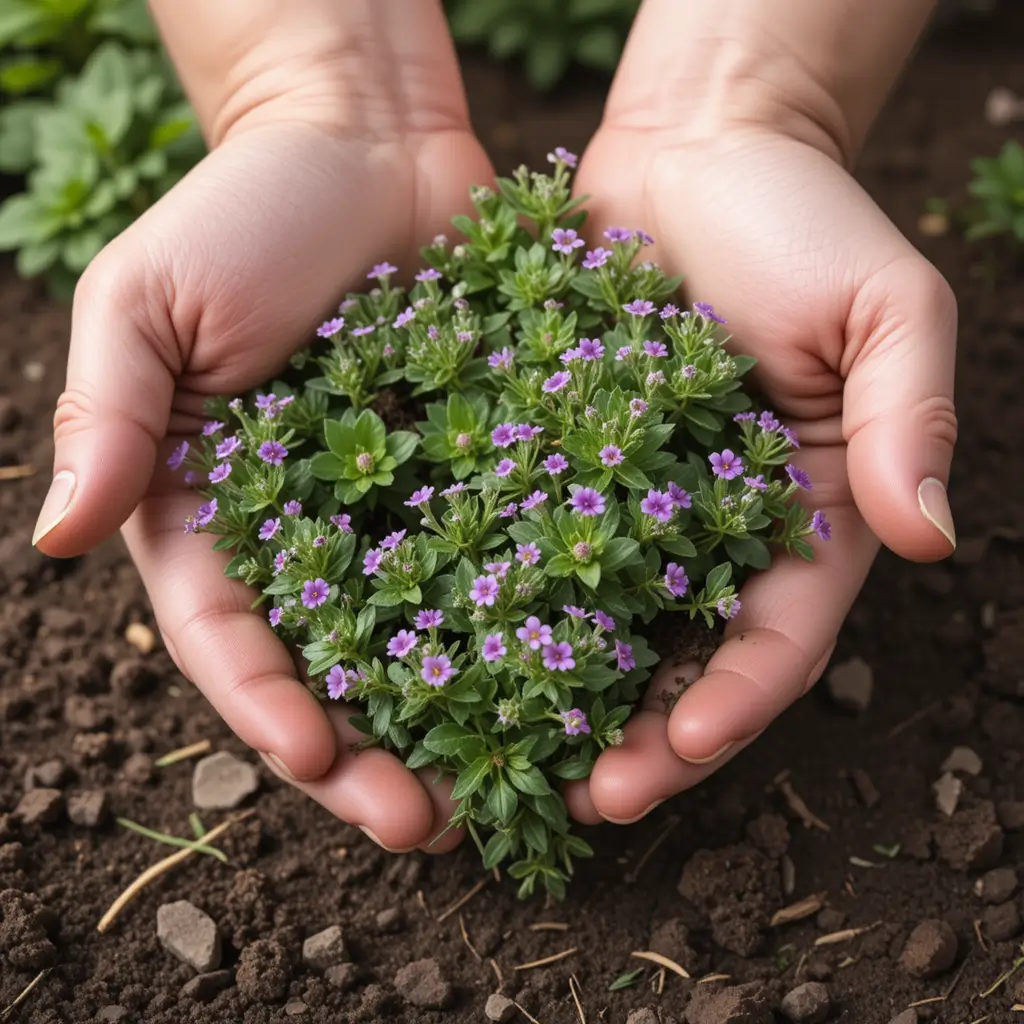
To keep your creeping thyme lawn looking its best, it’s essential to understand its watering, fertilization, and pruning needs. With the right care, your thyme lawn will remain a beautiful, fragrant, and sustainable part of your landscape.
Watering Requirements and Drought Management
Proper watering is crucial, especially during the establishment phase. Creeping thyme needs consistent moisture to develop a strong root system.
Establishment Phase Watering
During the first few weeks after planting, keep the soil consistently moist but not waterlogged. As the plants grow, you can gradually reduce the frequency of watering.
Long-term Drought Resistance Strategies
Once established, creeping thyme is highly drought-tolerant. However, occasional deep watering can help maintain its health and appearance during prolonged dry spells.
Fertilization Guidelines
Fertilizing your creeping thyme lawn can promote healthy growth and flowering. Consider using organic options like compost or well-balanced, slow-release fertilizers.
Organic Options
Organic fertilizers not only nourish your thyme but also contribute to soil health. Compost tea or fish emulsion are excellent choices for providing nutrients without the risk of over-fertilization.
When and How to Apply
The best time to fertilize is in early spring, just as new growth begins. Follow the manufacturer’s instructions for application rates to avoid over-fertilizing, which can harm the plants.
Pruning and Maintenance
Regular pruning is essential for maintaining a dense, weed-resistant thyme lawn. Prune your thyme after it finishes flowering to encourage new growth.
Promoting Dense Growth
To promote dense growth, lightly trim your thyme lawn periodically. This will help prevent weeds from taking hold and keep your lawn looking its best.
Managing Flowering
While the flowers of creeping thyme are a beautiful bonus, pruning them back after blooming can help maintain a neat appearance and encourage foliage growth.
Troubleshooting Common Problems with Creeping Thyme
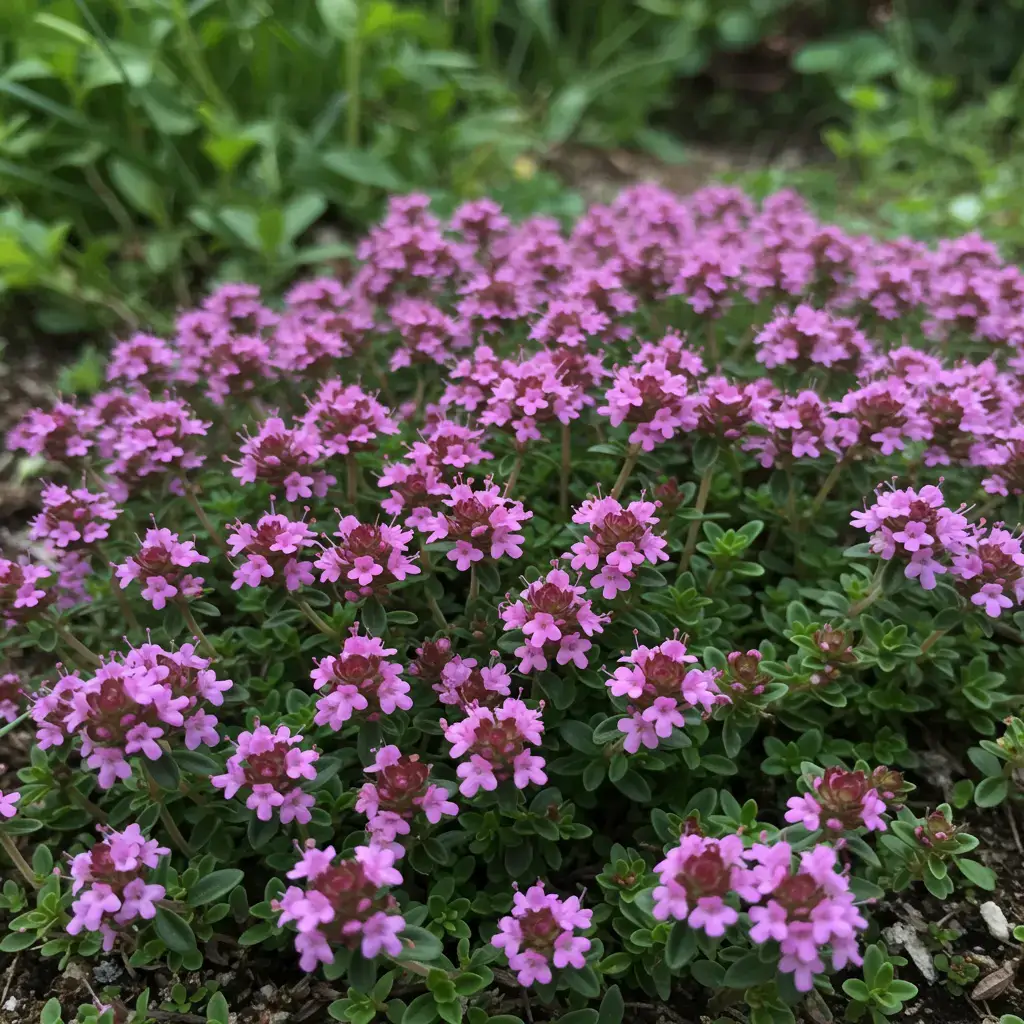
While creeping thyme is a hardy and adaptable ground cover, it can still encounter several challenges that may impact its health and appearance. Understanding these potential issues and how to address them is crucial for maintaining a thriving and fragrant thyme lawn.
Pest Management
Creeping thyme can be susceptible to various pests, including spider mites, aphids, and root weevils. These pests can cause damage by feeding on the plant’s foliage or roots, potentially weakening the plant.
Identifying Common Pests
Regular inspection is key to identifying pest issues early. Look for signs such as discolored or distorted leaves, and check for the presence of the pests themselves, often found on the underside of leaves or near the soil.
Natural Control Methods
For managing pests, consider using natural control methods such as neem oil or insecticidal soap. These can be effective against a range of pests and are generally safer for the environment than chemical pesticides.
Disease Prevention and Treatment
Diseases, particularly fungal infections, can be a problem in humid climates. Ensuring good air circulation and avoiding overwatering are key preventive measures.
Fungal Issues in Humid Climates
In humid conditions, fungal diseases can spread quickly. Removing affected areas and improving air circulation can help control the issue.
Root Rot Prevention
Root rot is often a result of overwatering. Ensuring the soil drains well and avoiding excessive watering can prevent this condition.
Growth Issues and Solutions
Patchy growth or decline in older plants can be addressed through proper maintenance and care.
Patchy Growth Remedies
For patchy growth, re-seeding or re-sodding the affected areas can be effective. Ensuring the soil is well-prepared before planting can also help prevent future patchiness.
Rejuvenating Older Plants
Older plants can be rejuvenated by pruning them back to encourage new growth. This can help maintain their vigor and appearance.
Conclusion:
You’ve taken the first step towards creating a beautiful, drought-tolerant lawn by considering creeping thyme seeds. By choosing this alternative, you’re not only reducing your water consumption but also creating a fragrant and sustainable landscape that will thrive for years to come.
With bulk creeping thyme seeds, you can cover larger areas and enjoy the benefits of this versatile plant. As you’ve learned, creeping thyme is relatively low maintenance and can tolerate foot traffic, making it an ideal choice for lawns, pathways, and garden borders.
As you cultivate your creeping thyme lawn, you’ll appreciate its beauty and fragrance. The tiny flowers will attract pollinators, and the foliage will release a pleasant aroma when walked upon. By following the steps outlined in this article, you’ll be on your way to enjoying a lush, sustainable landscape that brings joy and serenity to your outdoor space.

